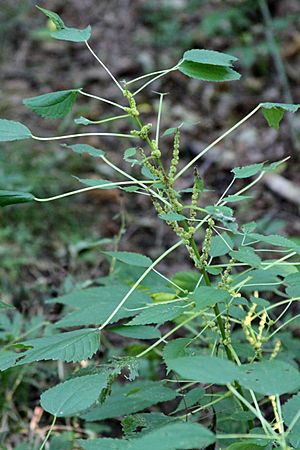False nettle facts for kids
Quick facts for kids False nettle |
|
|---|---|
 |
|
| Scientific classification | |
| Genus: |
Boehmeria
|
| Species: |
cylindrica
|
| Synonyms | |
|
|
The False Nettle (scientific name: Boehmeria cylindrica) is a plant that looks a bit like a nettle but doesn't sting! It's also called bog hemp. This plant is part of the Urticaceae family, which includes true nettles. You can find False Nettle growing across a large area, mainly in eastern North America and the Great Plains. It stretches from places like New Brunswick in Canada all the way down to Florida and Texas in the United States. You can also find it in Mexico, Central America, the Caribbean, and South America.
This plant is an herb or a small shrub. It can grow up to 160 centimeters (about 5 feet) tall. Usually, a single plant has both male and female flowers (this is called monoecious). But sometimes, you might find plants with only male or only female flowers (this is called dioecious). Its leaves usually grow in pairs opposite each other, but sometimes they can grow alternately along the stem. The flowers grow in a spike shape, with a small bunch of leaf-like parts at the very top.
Contents
What False Nettle Looks Like
False Nettle is a plant that loses its leaves every year (it's deciduous). It usually grows to be about 0.5 to 1.0 meter (1.5 to 3 feet) tall. Its leaves grow opposite each other on the stem. You might see small, spike-like hairs where the leaves meet the stem.
The leaves are shaped like an oval. They are typically 6 to 8 centimeters (about 2.5 to 3 inches) long and 3 to 4 centimeters (about 1 to 1.5 inches) wide. The flowers are green or greenish-white. They grow from the upper parts of the plant where the leaves join the stem.
False Nettle produces small, oval-shaped seeds. These seeds are covered in tiny, hook-like hairs. When the seeds are ready, they turn a dark brown color. The flower clusters look like spikes and can be 1 to 3 centimeters long. Male and female flowers often grow on different plants. The male flowers are usually grouped together more on their spikes. The female flowers are spread out more loosely along their spikes.
Where False Nettle Grows
You can find B. cylindrica all over North America, reaching into Central and South America. It naturally grows in northeastern Canada and most of the United States. This includes areas from Maine to Florida and west towards South Dakota and California.
False Nettle's Home
False Nettle prefers to live in wet to moderately moist deciduous woodlands. It grows best in areas that flood sometimes, like floodplains and low-lying river areas.
How False Nettle Lives
False Nettle relies on the wind for pollination. This means that wind carries its pollen from one plant to another. Because of this, its flowers don't need to attract many insects.
The larvae (young ones) of a type of fly called Neolasioptera boehmeriae can create small, spindle-shaped bumps called galls on the plant. False Nettle flowers during the summer and into the fall. During this time, its pollen can cause allergies for some people.
This plant is also an important food source for the caterpillars of certain butterflies. These include the eastern comma, the question mark, and the red admiral butterflies.
What Its Name Means
The first part of the scientific name, Boehmeria, honors a German botanist named Georg Rudolf Boehmer. He lived from 1723 to 1803. The second part, cylindrica, describes the plant's flower spikes. These spikes are generally shaped like a cylinder and grow where the leaves meet the stem.
See also
 In Spanish: Boehmeria cylindrica para niños
In Spanish: Boehmeria cylindrica para niños

